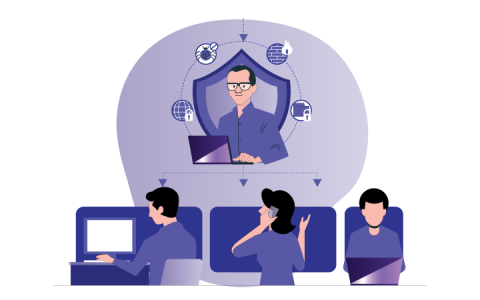
Introduction to Cybersecurity
Welcome to the digital age, where technology has become an integral part of our everyday lives. From online shopping and banking to social media and email communication, we rely heavily on the internet for various tasks. However, as we embrace the convenience and efficiency it offers, we must also be aware of the risks that come with it.
Cybersecurity is a term that has gained significant importance in recent years. It refers to the protection of computer systems, networks, and data from unauthorized access or damage. With cyber threats evolving at an alarming rate, organizations and individuals are constantly striving to stay one step ahead in this ongoing battle.
In this blog post, we will explore the three main goals of cybersecurity: protecting data and information, preventing cyber attacks, and ensuring business continuity. So let’s dive into the world of cybersecurity and understand why these goals are crucial for safeguarding our digital lives!
Goal 1: Protecting Data and Information
In today’s digital age, protecting data and information is one of the primary goals of cybersecurity. With the increasing reliance on technology for various aspects of our lives, it has become crucial to safeguard sensitive data from falling into the wrong hands.
One of the key reasons why protecting data and information is essential is to maintain privacy. Whether it’s personal or financial details, ensuring that this information remains confidential helps prevent identity theft and other fraudulent activities. Cybercriminals are constantly finding new ways to exploit vulnerabilities in systems, making it imperative for organizations and individuals alike to stay vigilant.
Another aspect of protecting data involves maintaining its integrity. This means ensuring that any stored or transmitted information remains unaltered and accurate. Unauthorized access or manipulation can lead to serious consequences, such as compromised trust between businesses and their customers.
Moreover, securing data also encompasses availability—making sure that authorized users can access it when needed without interruption. Downtime due to cyber attacks can result in significant financial losses for organizations, hinder productivity, damage reputations, and disrupt services provided by businesses.
To achieve the goal of protecting data and information effectively, it requires a multi-layered approach. This includes implementing robust firewalls, encryption methods, access controls, regular backups, and employee training programs on cybersecurity best practices, just to name a few.
Safeguarding sensitive data contributes not only to individual privacy but also protects businesses from potential liabilities arising from breaches. By prioritizing this goal in cybersecurity efforts at both organizational and individual levels, we can help create a safer online environment for all users!
Goal 2: Preventing Cyber Attacks
Goal 2: Preventing Cyber Attacks
In today’s digital age, where technology is an integral part of our lives, cyber attacks have become a major concern. The second goal of cybersecurity is to prevent these attacks and safeguard our online world.
Cyber attackers are constantly evolving their techniques to exploit vulnerabilities in systems and networks. This makes it crucial for organizations and individuals alike to stay one step ahead in the battle against cybercrime.
To achieve this goal, cybersecurity professionals employ various strategies and tools. One such strategy is implementing strong authentication protocols that ensure only authorized individuals can access sensitive information. Additionally, regular security assessments and penetration testing help identify any weaknesses before malicious actors can exploit them.
Another effective measure for preventing cyberattacks is educating users about potential threats. By providing training on best practices like creating strong passwords, recognizing phishing emails, and avoiding suspicious websites or downloads, individuals can play a vital role in protecting themselves and their organizations from cyber threats.
Furthermore, proactive monitoring of networks and systems enables early detection of potential intrusions or anomalies. This allows security teams to respond swiftly and mitigate any potential damage before it escalates into a full-blown attack.
Preventing cyberattacks requires constant vigilance as new threats emerge daily. It also demands collaboration between businesses, governments, individuals, and cybersecurity experts to share threat intelligence information effectively.
By focusing on prevention measures such as robust security protocols, user education programs, and continuous monitoring efforts, along with collaborative efforts among all stakeholders involved, we can collectively work towards minimizing the risk posed by cybercriminals.
Remember: prevention is always better than cure when it comes to cybersecurity!
Goal 3: Ensuring Business Continuity
Goal 3: Ensuring Business Continuity
In today’s interconnected digital world, businesses face a constant threat of cyber attacks that can disrupt their operations and compromise sensitive data. That’s where the goal of ensuring business continuity comes into play in cybersecurity.
Business continuity refers to the ability of an organization to maintain its essential functions and recover quickly from any disruption caused by cyber incidents. This goal focuses on minimizing downtime, preventing financial losses, and safeguarding the reputation of a company.
To achieve this goal, organizations need to develop robust incident response plans that outline steps to be taken during and after a cyber attack. These plans should include measures such as regular backups of critical data, redundant systems for key operations, and disaster recovery procedures.
Additionally, organizations must regularly assess their vulnerabilities through comprehensive risk assessments and implement appropriate security controls. This includes training employees on best practices for handling sensitive information, implementing strong access controls, regularly patching software vulnerabilities, and monitoring network traffic for any signs of suspicious activity.
Moreover, having effective communication channels is crucial to ensuring business continuity during a cyber crisis. Clear lines of communication between IT teams, management personnel, and and external stakeholders like customers or partners are necessary to coordinate efforts efficiently.
By prioritizing business continuity as one of the main goals in cybersecurity strategy planning,, companies can minimize disruptions caused by cyber attacks or other incidents, ultimately protecting their bottom line while maintaining trust with customers.
Protecting against potential threats requires ongoing effort,, but investing time and resources into achieving these three main goals will undoubtedly help businesses build stronger cybersecurity defenses.
The Role of Individuals in Achieving these Goals
The Role of Individuals in Achieving these Goals
In the vast and ever-evolving landscape of cybersecurity, individuals play a crucial role in achieving the three main goals. While organizations implement security measures and invest in advanced technologies, it is equally important for every individual to be vigilant and proactive when it comes to protecting data and information.
Individuals need to understand the importance of safeguarding sensitive data. This involves being cautious about sharing personal information online and ensuring strong passwords are used for all accounts. By taking responsibility for their own cyber hygiene, individuals can contribute significantly to the overall goal of protecting data.
Staying informed about potential cyber threats is vital. Individuals should educate themselves on common attack vectors such as phishing emails or malicious websites. By recognizing warning signs and practicing skepticism while browsing or receiving messages, they can prevent cyber attacks from succeeding.
Reporting any suspicious activities or incidents promptly is essential. By alerting relevant authorities or IT departments within organizations, individuals can help identify vulnerabilities and take necessary actions before a major breach occurs.
By actively participating in these efforts, individuals become an integral part of the cybersecurity ecosystem. Their vigilance contributes not only to their personal safety but also helps build a safer digital environment for everyone involved. Remember: cybersecurity is a collective effort that requires active engagement from each individual!
Challenges and Solutions in Cybersecurity
Challenges and Solutions in Cybersecurity
In today’s digital age, cybersecurity has become a critical concern for individuals and businesses alike. As technology advances, so do the threats that lurk in cyberspace. From hackers to data breaches, organizations face a myriad of challenges when it comes to protecting their sensitive information.
One major challenge is the ever-evolving nature of cyberattacks. Hackers are constantly finding new ways to exploit vulnerabilities in systems and networks. This means that cybersecurity measures must be continuously updated and adapted to stay one step ahead of these threats.
Another challenge is the sheer volume of data that needs to be protected. With the proliferation of digital devices and the rise of Internet-of-Things (IoT) technologies, there is an exponential increase in the amount of data being generated and transmitted every day. Ensuring the security of this vast amount of information poses significant challenges.
Additionally, human error remains a common cause of cybersecurity breaches. Whether it’s clicking on phishing emails or using weak passwords, individuals play a crucial role in maintaining online security but can also unknowingly compromise it.
To tackle these challenges, organizations need robust solutions that encompass both technology and human factors. Implementing multi-layered security measures such as firewalls, encryption protocols, and intrusion detection systems can help protect against external threats.
Furthermore, educating employees about best practices for cybersecurity is vital for preventing internal vulnerabilities. Regular training sessions on password hygiene, safe browsing practices, and recognizing phishing attempts can go a long way in reducing risks.
Collaboration between public-sector entities such as law enforcement agencies and private-sector organizations is also essential for sharing threat intelligence and coordinating responses to cyber incidents effectively.
While no system can guarantee absolute protection from cyber threats due to their ever-changing nature, staying vigilant by regularly updating software patches, conducting regular audits, having backup plans, implementing strong authentication methods like two-factor authentication, and adopting secure coding practices during application development processes will significantly enhance an organization’s cybersecurity posture.
The challenges in cybersecurity are vast and
Conclusion
Conclusion:
Achieving cybersecurity is an ongoing battle that requires constant vigilance and proactive measures. The three main goals of cybersecurity are to protect data and information, prevent cyberattacks, and ensure business continuity. These goals play a crucial role in safeguarding sensitive information, maintaining the integrity of systems, and minimizing the impact of potential breaches.
Protecting data and information involves implementing robust security measures such as encryption, firewalls, and access controls. By safeguarding critical data from unauthorized access or theft, organizations can maintain the trust of their customers and partners while complying with regulatory requirements.
Preventing cyber attacks requires a multi-faceted approach that includes regular vulnerability assessments, penetration testing, employee training on best practices for online security, and investing in advanced threat detection systems. With these preventive measures in place, organizations can significantly reduce the risk of falling victim to malicious activities.
Ensuring business continuity is essential for any organization’s long-term success. Cybersecurity plays a vital role in preserving operational efficiency by safeguarding against disruptions caused by cyber incidents like ransomware attacks or system failures. Regular backups of important data combined with disaster recovery plans enable businesses to quickly recover from any unforeseen events.



